Spiders With White Spots – Black and Brown (Pictures) – Identification Guide
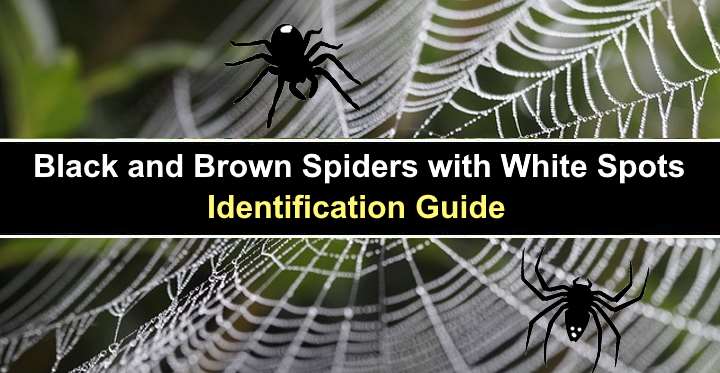
Black or brown spiders with white spots can include several species of spiders. The presence of white spots on a spider’s head, abdomen, or legs helps to identify individual types of spiders. White-spotted brown or black spiders aren’t necessarily an indication of a venomous or harmless spider. However, most of the spiders with white spots in this article are non-venomous spiders.
Black and brown spiders with white spots come in all shapes and sizes. For example, many furry black jumping spiders have a characteristic trait of three white spots on their abdomens. However, the smooth male black widow has white and red dots as well as white stripes. Or the brown mothercare spider has brown, tan, and white mottled patterns on its abdomen.
This article is a guide to identifying common types of black spiders with white spots and brown spiders with white dots. Knowing the identifying traits of black and brown spiders will help you recognize a venomous spider.
Types of Spiders With White Spots
Fuzzy jumping spiders are the most common black and white spiders with light spots. Many spider species in the genera Phidippus and Salticus are easily identified by their patterns of white spots on adult spiders.
Other black spiders with white spots include the parson spider, spiny-backed orb weaver with its white and black body, and the spotted ground swift spider with its grayish-white spots.
Like the western black widow, some species of male black widow spiders are brown spiders with white-spotted abdomens. Also, the orange-headed false black widow has a brownish head and a black abdomen with white spots.
How to Identify Spiders With White Spots (Black and Brown Spiders)
To identify species of spiders with white spots, look for whitish markings on the cephalothorax (head), abdomen, or legs. Looking at the size of the black or brown spider’s body and legs can help with identification. Additionally, some spiders with white, spotted patterns have bands around their spindly legs.
Brown or black spiders with white spots can also be types of furry spiders with hairy bodies. For example, black and white jumping spiders are easy to identify due to their bodies that are covered in spines. However, many common spiders with white dots or spots you find indoors have smooth bodies.
Another way to identify spiders with white spots is to look at their eyes. All types of spiders have multiple eyes, sometimes in two or three rows. Some species like the jumping spider have two large central eyes on the front of their heads
Types of Black Spiders With White Spots (Pictures and Identification)
Let’s look in more detail at types of large, small, and tiny black spiders with white spots.
Zebra Jumping Spider (Salticus scenicus)
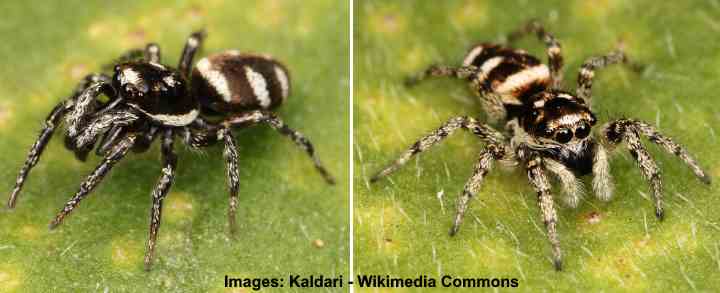
Zebra Jumping Spider (Salticus scenicus): male (left) and female (right)
The zebra jumping spider is a black spider with white spots on its cephalothorax and white stripes on its abdomen. Although this is a tiny black spider, it has a striking appearance due to its black spiny legs with white dots and the white stripe around its head.
The male black and white jumping zebra spider measures 0.2” to 0.23” (5 – 6 mm) long. The female zebra jumping spiders are similar size or slightly bigger and with smaller mouthparts (chelicerae).
Spider With White Spots Identification: The easiest way to identify the zebra jumping spider is by the many white dots on its black legs and two or three white dots on its furry black head.
Bold Jumping Spider (Phidippus audax)
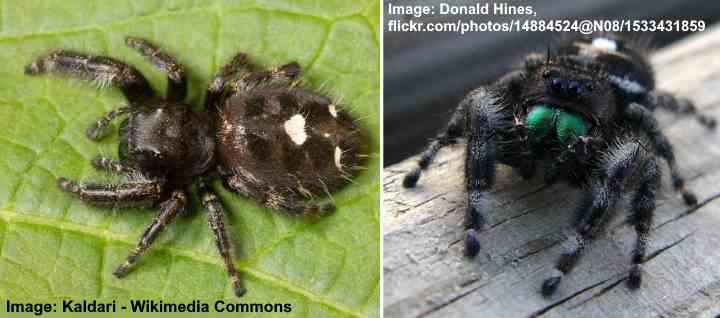
Bold Jumping Spider (Phidippus audax)
The bold jumping spider is a black spiny spider with three identifiable white dots on its back. You will also notice two rows of dark brown, almost dark markings on its abdomen. Other identifying features of the bold or daring jumping spider are white spines covering its dark legs.
The black and white bold jumping spider has an average body length of 0.31” (8 mm). In Florida, bold jumping spiders may have red, orange, or yellow spots.
Spider With White Spot Identification: The bold jumping spider has identifiable bright iridescent green or blue mouthparts and three white, heart-shaped marks on its abdomen.
Marbled Purple Jumping Spider (Phidippus purpuratus)
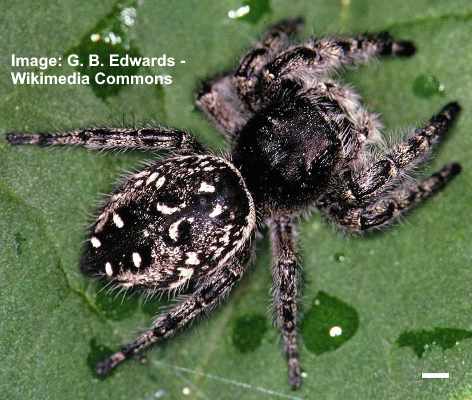
Marbled Purple Jumping Spider (Phidippus purpuratus)
The marbled purple jumping spider is a black and white spider, identified by its multiple white spots on its furry abdomen. Pictures of the purple jumping spider reveal white speckles on its cephalothorax and black and white spines on its stumpy legs. Look for two large conspicuous eyes on its head.
The marbled purple jumping spider measures 0.4” – 0.47” (10 – 12 mm) long and has a small leg span compared to its rounded, oval black and white abdomen and round head.
Spider With White Spots Identification: The marbled purple jumping spider is identified by white spots on its dark purple or black abdomen and white hairy spines covering its body.
Eastern Parson Spider (Herpyllus ecclesiasticus)
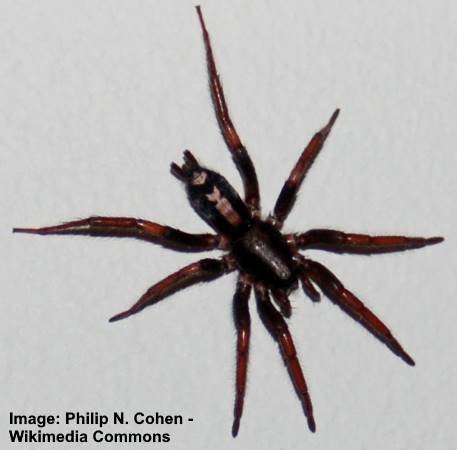
Eastern Parson Spider (Herpyllus ecclesiasticus)
The eastern parson spider is an aggressive spider with a black and dark brown body, gray hairs, and white spots on its abdomen. The characteristic trait of this hairy spider is the whitish-gray abdominal markings in an 18th-century cravat shape. Additionally, there is a distinctive white dot near its spinnerets.
The female eastern parson spider measures 0.4” to 0.8” (10 – 20 mm) long, and the males are slightly smaller.
Spider With White Spots Identification: The identifiable traits of the eastern parson spider are the distinctive white markings on its black abdomen and eight pointed legs that form a star shape.
Crablike Spiny-Backed Orb-weaver (Gasteracantha cancriformis)
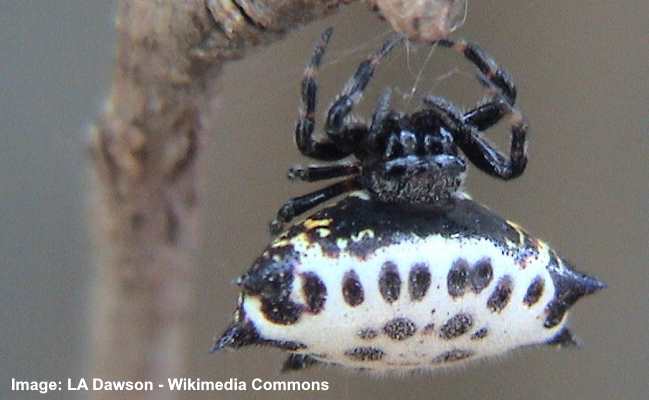
Crablike Spiny-Backed Orb-weaver (Gasteracantha cancriformis)
The spiny-backed orb-weaver is an unusual black and white spider with an oversized oval abdomen. This orb-weaver’s abdomen has six prominent spikes and fuzzy white hairs. The unique coloring makes the spider look white with black dots on its back. The spider’s underside is black with white dots.
The crablike spiny-backed orb-weaver spider measures 0.39” to 0.51” (10 – 13 mm) wide and 0.2” to 0.35” (5 – 9 mm) long.
Spider With White Spots Identification: The distinctive spiny-backed orb-weaver has a characteristic white and black abdomen with a white-spotted black belly on its underside.
Black Widow (Latrodectus elegans)
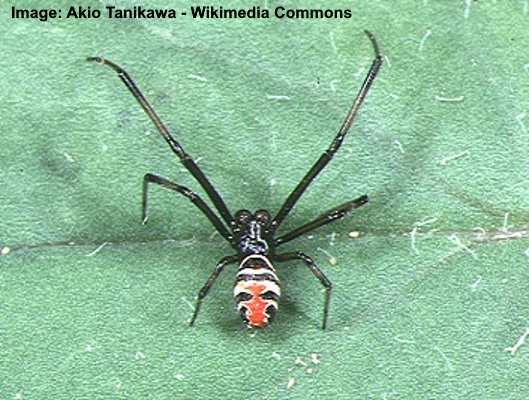
Black Widow (Latrodectus elegans)
The male Latrodectus elegans is a species of black widow spider with red and white abdominal markings. This harmless male spider has a black and white striped abdomen. The irregular red markings on the white stripes give the appearance of white spots. This relatively small spider has a huge leg span.
The black, white, and red Latrodectus elegans widow spider measures 0.39” (10 mm) and has a leg span of 1.18” (30 mm).
Spider With White Spots Identification: To identify the black widow Latrodectus elegans, look for the distinctive white stripes and red markings on a shiny black abdomen.
Spotted Ground Swift Spider (Nyssus coloripes)
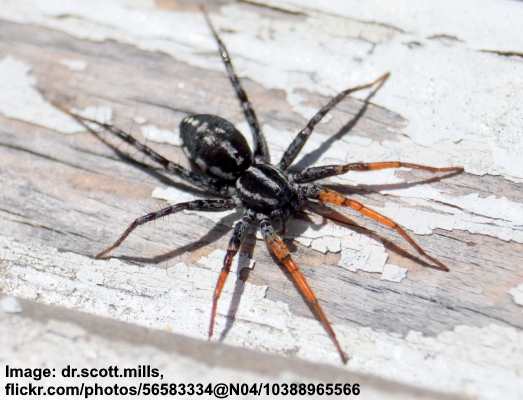
Spotted Ground Swift Spider (Nyssus coloripes)
The spotted ground swift spider is a black spider with bands of white spots running the length of its cephalothorax and abdomen. The characteristic trait of this fast-moving spider is its black and orange legs. The tiny spiders typically measure 0.23” – 0.27” (6 – 7 mm) long.
Spider With White Spots Identification: Also called the fleet-footed spider and painted swift spider, this black spider is identified by its white dots running the length of its body and its orange front legs.
Silver Argiope (Argiope argentata)
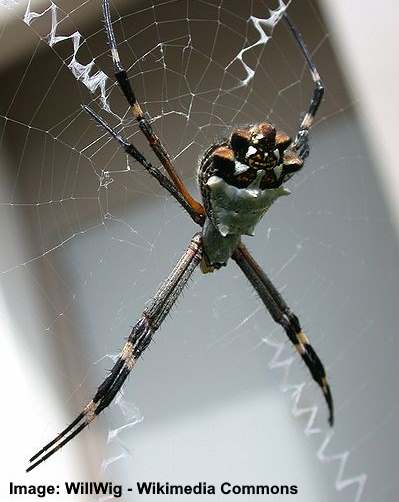
Silver Argiope (Argiope argentata)
The silver Argiope is a black spider with a silvery-white cephalothorax and a black and white abdomen. The black section of the spider’s abdomen has several white raised spots. A characteristic feature of the silver Argiope is its banded black and white spiny legs.
The small female spider only measures 0.47” (12 mm) and the male 0.16” (4 mm). However, the huge leg span of over 1” (2.5 cm), making the spiders look much larger.
Spider With White Spots Identification: The identification traits of the silver Argiope are its black and white body with white and orange spots and banded long legs.
Castianeira longipalpa
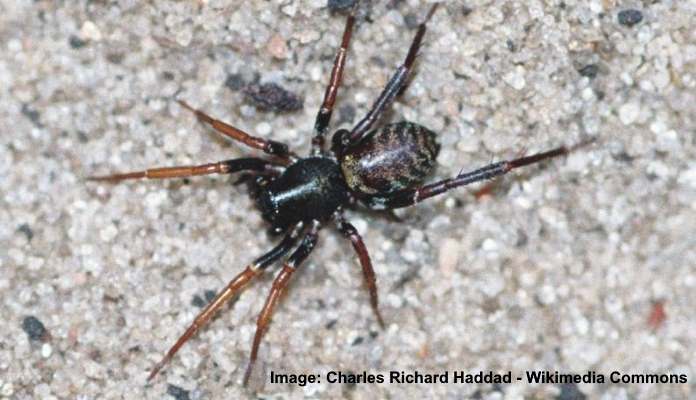
Castianeira longipalpa
The Castianeira longipalpa is a shiny black spider with orangey-brown and black legs and stripes of whitish or pink dots across its abdomen. This small black spider is native to North America and can be found lurking in crevices or under rocks. Classified as a true spider that is a type of ant-mimic spider, the arachnoid measures 0.2” to 0.4” (5 – 10 mm) long.
Spider With White Spots Identification: The Castianeira longipalpa is identified by its elongated abdomen with white spotted patterns on its black body.
Types of Brown Spiders With White Spots (Pictures and Identification)
Carefully looking for white spots or dots on brown spiders can help identify dangerous spiders. For example, the common brown recluse spider has a light brown body. However, there are no markings on its legs or body. This means that if the brown spider has white pigments or markings, it’s not a brown recluse.
Let’s look in more detail at ways to identify large and small brown spiders with white spots.
Western Black Widow Spider (Latrodectus hesperus)
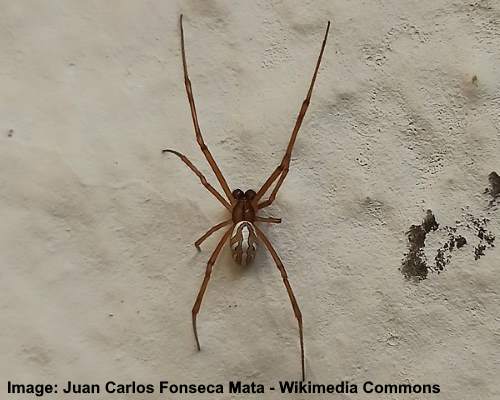
Male Western Black Widow Spider (Latrodectus hesperus)
The male western black widow spider looks like a brown widow with white spots. The tan-colored spider has an identifiable central white stripe and white spots on the sides of its bulbous abdomen. In addition, this brown and white spider has two identifiable discs above its eight eyes.
The western black widow spider is harmless and measures 0.27” to 0.31” (7 – 8 mm) long and has a leg span of 1” to 1.5” (25 – 38 mm).
Spider With White Spots Identification: The male western black widow spider is identified by its light brown color and white marking on its oval abdomen.
Orange-Headed False Black Widow Spider (Steatoda washona)
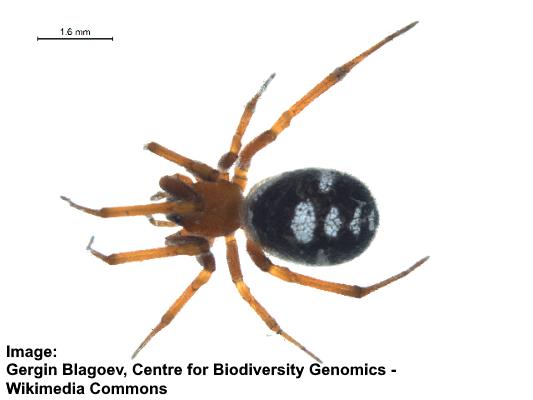
Orange-Headed False Black Widow Spider (Steatoda washona)
The orange-headed false black widow is an orange and black spider with several white spots on its egg-shaped abdomen. This unusual spider is classed as a tangle web spider. Its head and legs are brown in color, completely different from the black and white fuzzy abdomen.
Spider With White Spots Identification: To identify the orange-headed false black widow, look for the line of white spot-like markings down the center of its abdomen.
Noble False Widow (Steatoda nobilis)
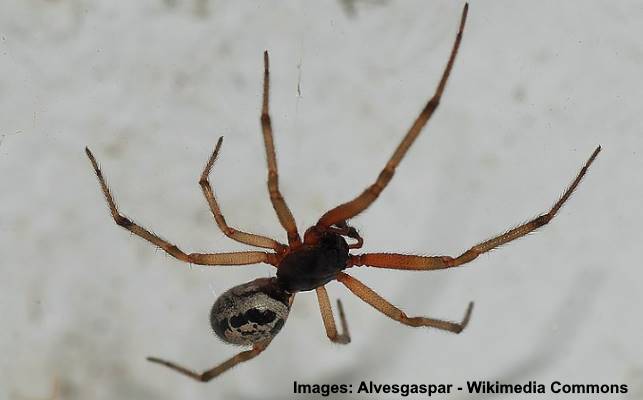
Noble False Widow (Steatoda nobilis)
The noble false widow looks like a brown widow, but it’s from a different genus. The false widow has a brown bulbous abdomen with large white, spot-like markings. The noble false widow spider has a black cephalothorax with long reddish-orange legs. The false widow can inflict a painful bite, although not as venomous as a black widow bite.
The female noble false widow spider measures 0.37” to 0.55” (9 – 14 mm). And like most spider species, the adult females are larger than the adult male spiders.
Spider With White Spots Identification: The noble false widow has an identifiable black head, reddish legs, and an egg-shaped, bulbous abdomen with distinctive creamy-white markings.
Tropical Orb-Weaver Spider (Eriophora ravilla)
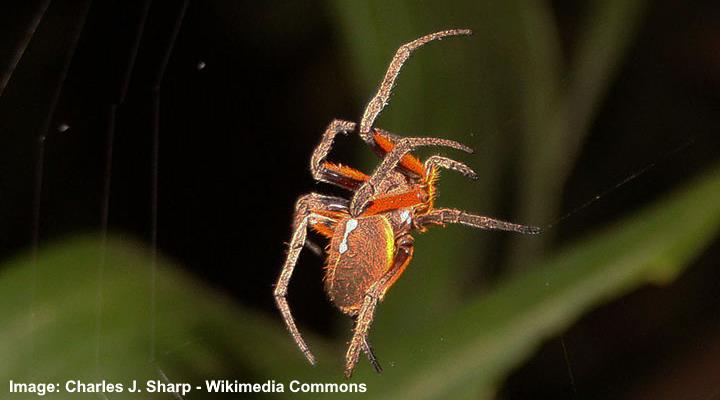
Tropical Orb-Weaver Spider (Eriophora ravilla)
The tropical orb-weaver is a brown spider with white spots on its back, white spots on the side of its cephalothorax, and orange hairs. This distinguishing feature of this orb-weaver is its fuzzy orange and brown appearance. In addition, you may notice that the white spots on its abdomen seem to run together, creating a white band.
The tropical orb weaver measures 0.47” to 0.94” (12 – 24 mm) long.
Spider With White Spots Identification: You can easily identify the brown tropical orb-weaver by its spiny orangey appearance and white spots on its back.
Dictyna arundinacea
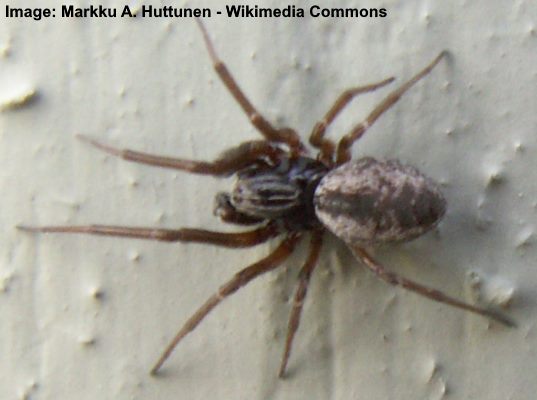
Dictyna arundinacea
The Dictyna arundinacea is a dark brown spider with an abdomen pattern of mottled white patches. The tiny brown spider has a brownish head with five rows of whitish hairs. There are also white hairs on the rear of the spider. Pictures of the brown and white spider show it has an egg-like, swollen abdomen.
Dictyna arundinacea measures 0.08” to 0.14” (2 – 3.5 mm) long.
Spider With White Spots Identification: To identify the Dictyna arundinacea, look for the white, spotted patches on its bulbous abdomen.
Raft Spider (Dolomedes fimbriatus)
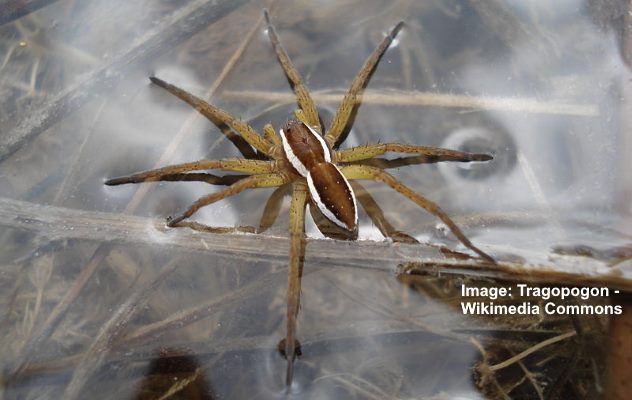
Raft Spider (Dolomedes fimbriatus)
The raft spider is a type of large orangey-brown spider with distinctive white stripes along its cephalothorax and abdomen with several tiny white dots on its back. The long legs of the brown and white raft spider are noticeably lighter in color and have small black spines. Adult females grow 0.35” to 0.86” (9 – 22 mm) long.
Spider With White Spots Identification: The identifying features of the raft spider are its brown body, white lateral stripes, and tiny white dots on its abdomen.
Mothercare spider (Phylloneta sisyphia)
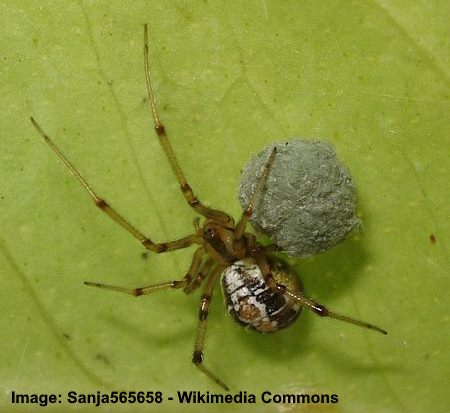
Mothercare spider (Phylloneta sisyphia)
The mothercare spider is a tiny brown spider with a bulbous abdomen covered in white and brown patterns. The mothercare spider’s legs are a brownish-yellow color with brown bands. There is also a prominent dark brown central band on its cephalothorax. Mothercare spiders measure 0.01” to 0.21” (2.5 – 5.5 mm) long.
Spider With White Spots Identification: The mothercare spider has identifiable yellowish, brown, and white patterns on its oval, rounded abdomen.
White-tailed spider (Lampona cylindrata)
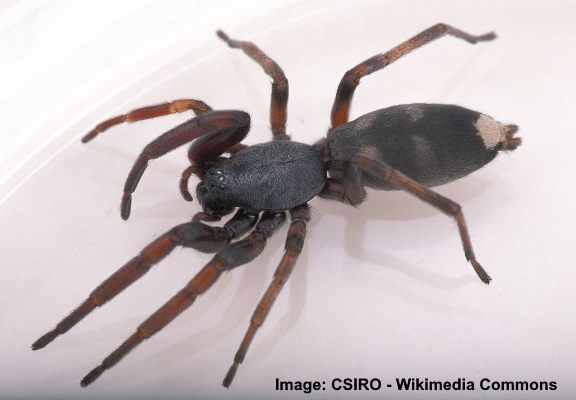
White-tailed spider (Lampona cylindrata)
The large white-tailed spider is a type of hunting spider with a dark brown or black body, brown legs, and a noticeable white spot at its tail end. Some species of white-tailed spiders have faint white, tan, or light brown patches on their abdomens. The blackish-brown spider measures up to 0.7” (18 mm) and has a leg span of 1.1” (28 mm)
Spider With White Spots Identification: This white-tailed spider is easy to identify due to the whitish tip at its spinneret, faint tan markings on its body, and reddish-brown legs.
Related articles:
